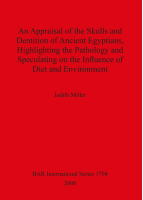Description
BOOK DESCRIPTIONWhen first studying Ancient Egyptian History, the author, a dental surgeon, was struck by the fact that, with the exception of a blind harpist or an occasional adipose figure, the Ancient Egyptian, was portrayed as healthy and fit with a superb physique. However, the reality was somewhat different. It has been discovered in previous studies of the mummies and the profusion of skeletal material which are available in many collections that their lives were far from ideal and many died in pain with diseases found in modern man. Then there are the many medical papyri which give prescriptions for treatments. Some were magical and were, in reality, spells to rid the sick individual of possession by a malign spirit. However some were rational and were passedon from doctor to doctor. This research was undertaken to investigate whether changes in the diet over a period of 4000 years had a direct effect on the dentition of the ancient Egyptian. The abundance of specimens in various collections made it possible to examine complete skulls to detect dental and bone pathology which may have been influenced by disease and the environment in which they lived. Analysis of the literature of past surveys carried out in tombs has revealed much information. Tomb paintings symbolised an ideal presentation of food for the afterlife. There are scenes illustrating agriculture and irrigation of the land. In museum collections there are papyri listing rations allotted to workmen and soldiers. Of particular importance are the burial goods. There are flagons containing dried remnants of wine and beer. There are mummified joints of beef. Offerings of fruit and grain are identifiable and have been analysed. Bread offerings, found in abundance, have been investigated to differentiate organic and inorganic components. From archaeological excavations, butchered bones from a variety of animals have been identified and the burial sites give clues as to the extent of the fertile area of the Nile Valley at different periods during the millennia. This historical evidence has been examined to evaluate the extent of medical knowledge at various periods and this has been related to the pathology found.











